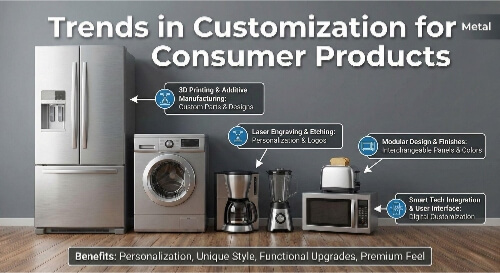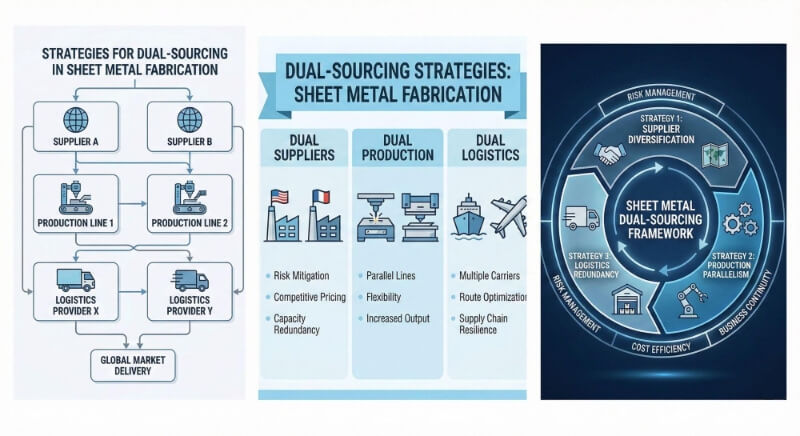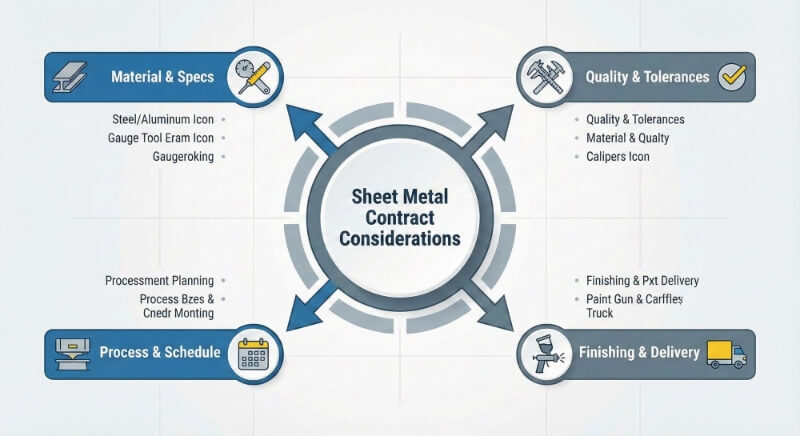금속 부품에 녹이 슬기 시작하면 성능이 저하됩니다. 많은 공장에서 프라이머나 코팅제를 사용하여 녹을 늦추려고 노력합니다. 그러나 이러한 모든 방법이 잘 작동하거나 오래 지속되는 것은 아닙니다. 흑인산염 코팅은 금속 표면을 보호하여 더 나은 솔루션을 제공합니다. 흑인산염 코팅은 강도를 높이고 마모를 줄이는 견고한 층을 형성합니다.
흑인산염에는 몇 가지 장점이 있습니다. 공정이 빠르고 적용하기 쉬우며 다양한 유형의 강철 부품에 사용할 수 있습니다. 다음으로 흑인산염 코팅의 작동 방식과 주요 특징, 그리고 가장 일반적으로 사용되는 위치를 살펴보세요.
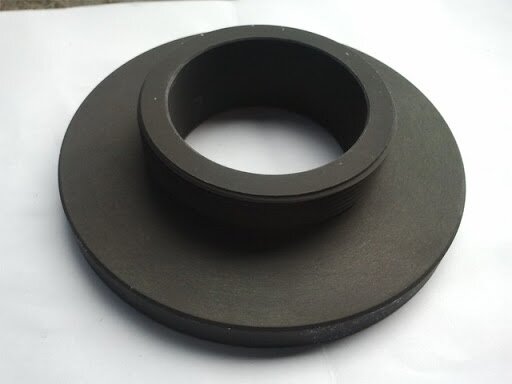
흑인산염 코팅이란 무엇인가요?
흑인산염 코팅은 화학적 전환 공정입니다. 강철에 얇고 짙은 회색 또는 검은색의 결정성 인산염 층을 적용합니다. 이는 부품을 인산과 기타 첨가된 화학 물질의 뜨거운 혼합물에 담글 때 발생합니다. 코팅은 금속에 달라붙어 약간 거친 느낌의 보호 표면을 만듭니다.
이 코팅은 마찰을 줄이고, 가벼운 녹 방지 기능을 제공하며, 기름이나 페인트가 표면에 잘 남는 것을 개선합니다. 자체적으로 녹을 완전히 막지는 못하지만 다른 보호 마감재를 위한 베이스 레이어 역할을 합니다.
코팅 두께는 보통 0.0001~0.0003인치로 얇습니다. 부품의 크기에 큰 영향을 미치지 않으므로 꼭 맞거나 정밀한 측정이 필요한 부품에 적합합니다.
인산염 코팅의 과학
인산염 코팅은 강철과 특수 인산염 용액 사이의 제어된 화학 반응을 통해 작동합니다. 이 반응은 금속 표면에 결합하는 결정층을 형성합니다. 그 결과 부품의 성능을 향상시키는 강력하고 보호적인 마감 처리가 이루어집니다.
흑인산 염의 화학 성분
흑인산염 코팅은 대부분 인산철(FePO₄)로 만들어집니다. 종종 망간이나 아연과 같은 추가 원소가 포함되기도 합니다. 코팅 용액에는 인산, 물, 금속염이 포함되어 있습니다. 강철 부품을 이 가열된 혼합물에 담그면 산이 표면과 반응합니다.
이 반응은 금속을 가볍게 용해시킵니다. 동시에 인산염 결정이 형성되어 표면에 부착됩니다. 이 짙은 회색 또는 검은색 결정은 균일하고 약간 거친 질감을 가지고 있습니다. 이 질감은 오일과 페인트가 더 잘 붙는 데 도움이 됩니다.
코팅은 단순히 부품 위에 얹어지는 것이 아니라 표면과 융합됩니다. 이러한 결합은 레이어에 강도를 부여하고 부품이 응력과 마찰에 더 잘 견딜 수 있도록 도와줍니다.
코팅에서 망간 대 아연의 역할
망간과 아연은 인산염 코팅에 흔히 사용되는 첨가제입니다. 각 첨가제는 부품의 필요에 따라 서로 다른 이점을 제공합니다.
망간 인산염(MnPO₄)은 더 두껍고 견고한 코팅을 만듭니다. 기어나 부싱처럼 움직이는 부품에 적합합니다. 결정이 클수록 더 많은 오일을 보유할 수 있어 윤활에 도움이 되고 마모를 줄여줍니다.
인산아연(Zn₃(PO₄)₂) 는 더 부드럽고 미세한 층을 형성합니다. 녹을 방지하고 페인트가 잘 붙도록 도와줍니다. 많은 자동차 부품은 도장 전에 인산아연으로 코팅됩니다.
흑인산염에는 일반적으로 아연이 더 많이 함유되어 있어 특히 심한 마모 대신 녹 방지 및 외관에 중점을 두는 일반적인 용도에 더 적합합니다. 망간과 아연 중 어떤 것을 선택할지는 실제 부품이 어떻게 사용될지에 따라 달라집니다.
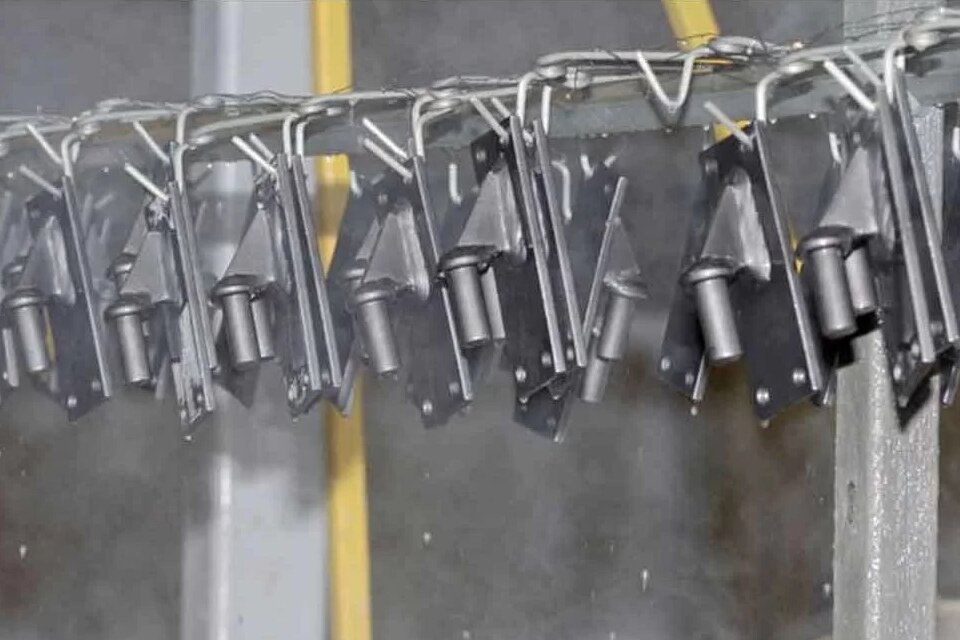
흑인산염 코팅 공정은 어떻게 진행되나요?
흑인산염 코팅 공정에는 몇 가지 간단한 단계가 포함됩니다. 각 단계는 최종 표면의 모양, 지속 시간, 실제 사용 시 성능에 영향을 미칩니다.
표면 준비
첫 번째 단계는 금속 부분을 청소하는 것입니다. 모든 그리스, 기름, 먼지, 녹을 제거해야 합니다. 표면이 깨끗하지 않으면 코팅이 잘 붙지 않고 오래 지속되지 않을 수 있습니다.
대부분의 부품은 알칼리성 탈지제를 사용하여 절단 또는 취급 시 발생하는 기름을 제거합니다. 녹이나 오래된 코팅이 있는 경우 산 세척을 사용하여 벗겨낼 수 있습니다. 세척 후에는 부품을 물로 헹구어 남은 화학 물질을 제거합니다.
인산염 용액 화학 및 조건
다음으로 부품을 가열된 인산염 욕조에 넣습니다. 이 수조에는 인산, 아연 또는 망간 염 및 기타 첨가제가 포함되어 있습니다. 온도는 보통 160°F에서 200°F 사이로 유지됩니다.
부품이 용액에 닿자마자 반응이 시작됩니다. 금속 표면이 약간 용해되고 인산염 결정이 형성되고 결합하기 시작합니다.
수조에서 보내는 시간은 필요한 코팅에 따라 다릅니다. 대부분의 부품은 5~15분 동안 용액에 머무르지만 시간이 길어질수록 코팅이 더 두꺼워집니다.
헹굼, 중화 및 건조
인산염 처리가 완료되면 부품을 깨끗한 물로 헹굽니다. 이렇게 하면 반응이 멈추고 느슨해지거나 여분의 물질이 제거됩니다. 일부 공정에는 남은 산을 제거하고 얼룩이나 가루가 쌓이는 것을 방지하기 위한 중화 헹굼이 포함됩니다.
헹구고 나면 부품이 건조됩니다. 건조는 송풍기, 가열 또는 두 가지 모두로 할 수 있습니다. 다음 단계로 진행하거나 보관하기 전에 부품이 완전히 건조되어야 합니다.
사후 처리 옵션
흑인산염 코팅은 약간 다공성이기 때문에 약간의 수분이나 공기가 통과할 수 있습니다. 보호 기능을 강화하기 위해 최종 처리를 추가하는 경우가 많습니다.
이 후처리에는 일반적으로 오일, 왁스 또는 실런트가 포함됩니다. 이들은 표면의 작은 구멍을 메우고 물이나 공기가 금속에 닿는 것을 차단합니다. 오일이 가장 일반적입니다. 오일은 매끄러운 마감을 더하고 마찰을 줄이며 부품을 더 짙은 검은색으로 보이게 합니다.
이 마지막 단계는 부품이 마른 후 담그거나 뿌리는 것입니다. 두께는 거의 추가되지 않지만 코팅이 더 오래 지속되고 더 잘 작동합니다.
흑인산염 코팅의 주요 특성
흑인산염 코팅은 강철 부품에 독특한 외관과 기능을 부여합니다. 다음은 여러 산업 분야에서 인기를 얻고 있는 가장 중요한 특성입니다.
표면 모양 및 텍스처
코팅은 짙은 회색에서 검은색입니다. 무광택의 반사되지 않는 마감을 만듭니다. 공구나 총기 부품과 같이 눈부심이 적은 부품에 이상적입니다.
인산염 결정으로 인해 질감이 약간 거칠어집니다. 이는 표면이 기름이나 페인트를 머금는 데 도움이 됩니다. 공정이 올바르게 완료되면 마감이 균일하고 깨끗합니다.
내식성 속성
흑인산염은 그 자체로 가벼운 부식 방지 기능을 제공합니다. 녹의 속도를 늦추지만 녹을 완전히 막지는 못합니다. 코팅은 일부 습기와 공기가 노출된 강철에 닿는 것을 차단합니다.
오일이나 왁스와 함께 사용하면 저항력이 크게 향상됩니다. 최상층은 모공을 메우고 습기를 차단하여 실내에서 사용하거나 사용하기 전에 보관할 부품에 적합합니다.
페인트 접착력 향상
인산염 처리 후 남은 거칠고 다공성 표면은 페인트가 더 잘 붙도록 도와줍니다. 페인트가 표면 위에 앉지 않고 표면 속으로 스며듭니다. 이렇게 하면 시간이 지나면서 페인트가 벗겨지거나 벗겨지는 것을 방지할 수 있습니다.
그렇기 때문에 흑인산염을 페인트 칠하기 전에 베이스 코트로 사용하는 경우가 많습니다. 이는 도장된 부품의 외관과 수명을 모두 향상시킵니다.
윤활성 및 내마모성
흑인산염은 슬라이딩 부품 사이의 마찰을 줄여줍니다. 코팅이 오일을 잘 잡아주어 사용 중에 부품이 원활하게 움직일 수 있도록 도와줍니다.
따라서 다음과 같은 경우에 유용합니다. 패스너, 기어 및 가벼운 마모에 직면한 부품에 사용할 수 있습니다. 하드 코팅이나 도금 하지만 저비용의 가벼운 보호가 필요한 곳에서 잘 작동합니다.
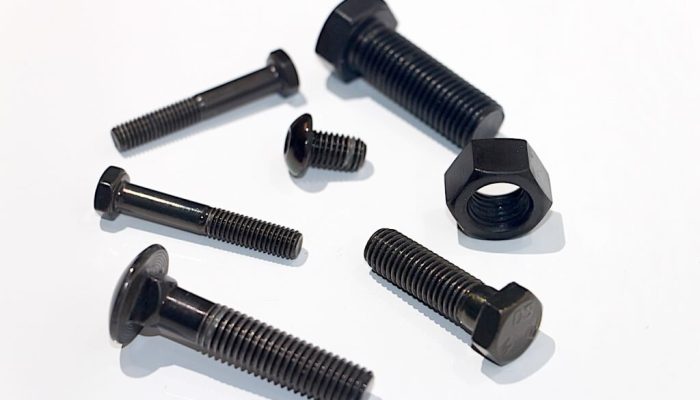
흑인산염 코팅에 적합한 재료
흑인산염 코팅은 철 금속(철 기반 소재)에 가장 잘 어울립니다. 소재 호환성에 대해 알아야 할 사항은 다음과 같습니다:
저탄소 및 중탄소 강재
흑인산염은 인산염 용액과 반응하기에 적합한 표면 화학성을 가진 저탄소강 및 중탄소강에서 가장 잘 작동합니다.
이 코팅은 탄소강 패스너에 자주 사용됩니다, 괄호및 부싱을 사용합니다. 층이 고르게 형성되고 잘 달라붙어 윤활성과 내식성이 향상됩니다.
주철 및 합금강
주철도 인산염 처리할 수 있습니다. 코팅이 탄소강처럼 매끄럽지 않을 수 있지만 여전히 보호 층을 형성합니다. 주철의 다공성 표면은 코팅 후 오일을 보유하는 데 도움이 되어 녹에 대한 저항력을 높여줍니다.
일부 합금강도 잘 반응하지만 합금 함량에 따라 다릅니다. 크롬이나 니켈 함량이 높은 강철은 강하게 반응하지 않아 코팅이 약하거나 고르지 않을 수 있습니다.
부적합한 금속과 실패하는 이유
알루미늄, 스테인리스 스틸, 구리 또는 황동에는 흑색 인산염 코팅이 적용되지 않습니다. 이러한 금속은 인산염 결정이 형성되는 데 필요한 표면 화학 성분이 부족합니다.
스테인리스 스틸에는 반응을 차단하는 수동 크롬 층이 있습니다. 구리와 황동은 철과 같은 방식으로 산과 반응하지 않습니다.
이러한 금속을 인산염 용액에 넣으면 변색되거나 구멍이 생기거나 코팅되지 않은 상태로 남을 수 있습니다. 기타 표면 처리처럼 아노다이징 처리, 패시베이션또는 도금하는 것이 더 나은 옵션입니다.
흑인산염 대 흑색 산화물
흑인산염과 흑산화물은 강철 표면을 어둡게 하고 성능을 향상시킵니다. 그러나 이들은 서로 다른 공정을 통해 만들어지며 용도가 약간 다릅니다.
흑인산염은 화학적 변환 코팅입니다. 강철 표면에 인산염 결정 층을 형성합니다. 이 코팅은 약간 다공성이며 기름을 잘 머뭅니다. 마찰을 줄이고 부식을 늦추며 페인트 접착력을 개선하는 데 도움이 됩니다. 약 0.0001~0.0003인치 정도의 두께가 추가됩니다.
흑색 산화물 도 화학적 처리이지만 강철의 최상층을 마그네타이트(Fe₃O₄)로 변환합니다. 이 층은 약 0.00002인치로 훨씬 더 얇습니다. 블랙 옥사이드는 더 어둡고 빛나는 마감을 제공합니다. 엄격한 공차가 중요한 공구, 건 부품 및 정밀 부품에 자주 사용됩니다.
주요 차이점:
- 두께: 인산염이 더 두껍습니다. 흑색 산화물은 매우 얇습니다.
- 표면 느낌: 인산염은 무광택의 약간 거친 질감입니다. 흑색 산화물은 매끄럽고 광택이 있습니다.
- 착용: 인산염은 윤활성을 더욱 향상시킵니다. 흑색 산화물은 오일로 후처리하지 않으면 내마모성이 떨어집니다.
- 부식 방지: 둘 다 녹에 잘 견디려면 오일이나 왁스가 필요합니다. 인산염은 오일을 더 잘 붙잡는 경향이 있습니다.
- 색상: 인산염은 짙은 회색에서 검은색입니다. 흑색 산화물은 진한 검은색입니다.
올바른 선택은 용도에 따라 다릅니다. 슬라이딩 부품, 볼트 및 오일이 필요한 부품에는 흑인산염을 사용합니다. 표면 디테일이나 밀착감이 더 중요한 경우에는 흑색 산화물을 선택하세요.
흑인산염 코팅 사용의 이점
흑인산염 코팅은 보호, 기능 향상 또는 특정 외관이 필요한 부품에 실질적인 이점을 제공합니다. 높은 비용이나 복잡한 공정 없이도 가치를 더할 수 있습니다.
향상된 내식성
코팅은 금속과 공기 사이의 장벽 역할을 합니다. 그 자체로 녹을 늦춰줍니다. 오일이나 실란트와 함께 사용하면 보호 기능이 크게 향상됩니다.
습기를 차단하고 보관, 배송 또는 초기 사용 중에 부품을 보호하는 데 도움이 됩니다. 무거운 도금이나 페인트 없이도 녹 방지 기능을 추가하는 것은 간단합니다.
향상된 윤활성 및 내마모성
흑인산염은 오일을 잘 잡아주어 부품의 갈링과 마찰에 대한 저항력을 높여줍니다. 패스너를 더 쉽게 설치할 수 있고 슬라이딩 부품이 더 부드럽게 움직입니다.
저부하 환경에서 금속 간 마모를 줄여줍니다. 하드 코팅을 대체할 수는 없지만 응력이 낮은 부품의 기본적인 마모 방지에는 효과적입니다.
심미적이고 반사되지 않는 마감 처리
검은 인산염의 어둡고 무광택 외관은 깔끔하고 전문적입니다. 밝은 마감재보다 지문과 스크래치를 더 잘 숨깁니다.
눈부심이 적은 표면은 공구, 총기 및 기계류에 유용합니다. 너무 광택이 나거나 화려해 보이지 않으면서도 부품을 균일하고 은은하게 마감할 수 있습니다.
산업 전반의 애플리케이션
흑인산염 코팅은 강철 부품의 기본적인 보호, 부드러운 움직임 또는 깔끔한 저광택 마감이 필요한 많은 산업에서 사용됩니다. 단순히 외관을 위한 것이 아니라 성능과 수명을 개선하여 가치를 더합니다.
자동차
흑인산염은 자동차 산업에서 표준입니다. 볼트, 브래킷, 부싱, 와셔, 브레이크 부품과 같은 부품은 종종 이 처리를 받습니다. 이 코팅은 녹을 방지하고 조립을 더 쉽게 만들어 줍니다.
총기류
총기류에서 흑인산염은 무광택의 광택이 없는 외관을 위해 사용됩니다. 눈부심을 줄이고 전문적이고 전술적인 외관을 제공합니다. 배럴, 리시버, 내부 부품과 같은 총기 부품은 표면 강도가 높아지는 이점을 누릴 수 있습니다.
산업기계
흑인산염은 공장 공구와 기계에도 사용됩니다. 패스너, 슬라이딩 부품, 샤프트 및 가이드에서 발견됩니다. 이 코팅은 특히 서로 마찰하거나 움직이는 부품 사이의 마찰을 줄이는 데 도움이 됩니다.
군용 장비
군용 장비는 종종 혹독한 환경에 직면합니다. 흑인산염은 무기 부품, 마운트 및 하드웨어에 사용됩니다. 흑인산염은 눈부심이 적고 취급 시 견고하며 오일과 함께 사용하면 녹을 방지합니다.
결론
흑인산염 코팅은 강철 부품에 얇고 어두운 층을 형성하는 화학 공정입니다. 내식성을 개선하고 윤활성을 더하며 페인트 접착력을 향상시키고 깨끗하고 무광택 마감 처리를 제공합니다. 패스너, 공구, 자동차 부품 및 군사 장비에 이상적입니다.
금속 부품에 적합한 표면 마감을 선택하는 데 도움이 필요하신가요? 팀에 문의 를 참조하여 흑인산염 코팅 등에 대한 전문가 가이드를 확인하세요.
안녕하세요, 저는 케빈 리입니다

지난 10년 동안 저는 다양한 형태의 판금 제작에 몰두해 왔으며 다양한 워크숍에서 얻은 경험에서 얻은 멋진 통찰력을 이곳에서 공유했습니다.
연락하세요

케빈 리
저는 레이저 절단, 굽힘, 용접 및 표면 처리 기술을 전문으로 하는 판금 제조 분야에서 10년 이상의 전문 경험을 갖고 있습니다. Shengen의 기술 이사로서 저는 복잡한 제조 문제를 해결하고 각 프로젝트에서 혁신과 품질을 주도하는 데 최선을 다하고 있습니다.

